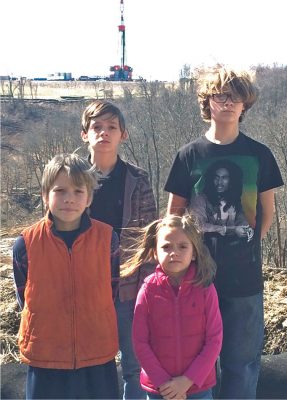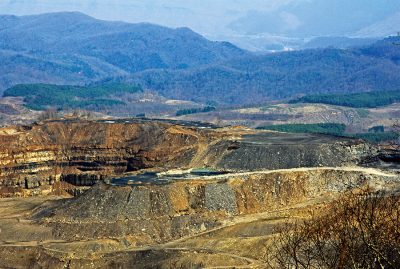The Human Impact: Mining and Fracking in Appalachia
By Elizabeth E. Payne
Central Appalachia has a wealth of natural resources, but extracting fossil fuels has come at a high price to the communities living near mountaintop removal coal mining and natural gas fracking sites.
Mortality rates in coal-mining counties of Appalachia lagged 24 years behind the national average, according to a 2008 study by Dr. Michael Hendryx, then of West Virginia University. That’s after adjusting for the social and economic inequalities — such as levels of education and rates of poverty — that affect life expectancies across the region as a whole.
Additional studies have documented increased rates of illnesses including cancers and respiratory and heart diseases. And a similar pattern is emerging in communities near fracking sites.
Initiatives such as the Mountain Air Project — a five-year study on the reduced lung health in Eastern Kentucky — are tackling the health disparities in Appalachia. Other research is focused on identifying possible causes, such as the extractive industries themselves.
A Truckload of Problems
Winding through the hills and hollers of Central Appalachia, small mountain roads are bearing far more traffic than they were ever intended to. A steady stream of trucks going back and forth from mountaintop removal coal mining and natural gas fracking sites is doing more than inconveniencing local communities. It’s making them sick.
“This unique geographic characteristic of the region means that roadways typically travel along valley bottoms, and homes are concentrated along these roadways. So the potential for particulate matter pollution to be exacerbated in this region is quite large,” says Dr. Viney Aneja, a professor in the Department of Marine, Earth and Atmospheric Sciences at North Carolina State University.

Heavy traffic to and from a fracking well pad causes a dust cloud along a small roadway in West Virginia. Aug. 15, 2014. Photo courtesy of The FracTracker Alliance, www.fractracker.org/photos
Particulate matter pollution refers to particles in the air of different sizes and from different sources. The smaller the particles are, the more risk they pose to human health. Larger particles, such as pollen or dust, are roughly one-fifth the diameter of a human hair and can cause irritation to airways. Smaller particles, roughly one-twentieth the diameter of a human hair, can form from chemical reactions between naturally occurring and industrially derived gases and liquids. The resulting compounds, such as sulfuric and nitric acids, lead to further health risks.
Even smaller particles, known as ultrafines, are one-millionth the size of a human hair and can penetrate deep into lungs on a cellular level. Such particles come from gas and diesel engines and energy production, among other sources, and research is beginning to demonstrate significant health risks from exposure.
In August 2008, Dr. Aneja spent two weeks collecting information about the amount of small particles polluting the air along roadways near Roda, Va. His research was initiated after residents complained about the problem and was supported in part by the Sierra Club.
Aneja’s research tested for comparatively large particles in the air resulting from coal trucks passing along the roadways, and it found that during times of heavy traffic the area had up to three times more particulate matter than recommended by the U.S. Environmental Protection Agency’s air quality standards.
According to The Allegheny Front, Dr. Michael McCawley, interim chair of the Department of Occupational and Environmental Health Sciences at West Virginia University, has made a similar connection with trucks traveling to and from fracking well pads.
What the Frack?!
As natural gas increasingly displaces coal as the nation’s leading source of electricity, equally dismal health impacts are emerging in the communities living near fracking sites.
Dr. Jill Kriesky is the associate director of the Southwest Pennsylvania Environmental Health Project, a nonprofit public health organization focused on the well-being of communities near the state’s natural gas extraction sites. The group was founded five and a half years ago in order “to provide timely, trusted and accurate information for residents who think their health has been impacted by shale gas drilling,” according to Kriesky.
The organization offers environmental and health assessments to help track changes in individuals’ health and monitor the air and water in their homes. They are also collecting information for a national health registry for people who believe their health is or could be impacted by unconventional oil and gas development.
According to Kriesky, the health problems the organization is witnessing correspond to those found through academic research and include coughs and irritation in the nose and throat, sleeplessness, headaches, stress and anxiety. Irritation to eyes and skin, as well as gastrointestinal problems and effects on newborn birth weights and birth outcomes, have also been observed.

Lois Bower-Bjornson’s children have experienced nosebleeds and skin irritations since fracking wells began operating near their home in Southwest Pennsylvania. Photo by Lois Bower-Bjornson
This observation is supported by a study published in April 2017 that found while the infant mortality rate in Pennsylvania fell overall during the periods studied, in the five most heavily fracked counties the total number of infant mortalities increased from 36 between 2003 and 2006 — before the expansion of fracking — to 60 between 2007 and 2010, after the expansion of fracking. The study found some association with contaminated well water.
Kriesky said that the Environmental Health Project has also noticed an increase in social stress suffered by communities near fracking sites.
“The community’s completely divided, and industry does that on purpose, so they can pit neighbor against neighbor,” says Lois Bower-Bjornson, whose family lives within 1,000 feet of a natural gas well pad in Southwest Pennsylvania.
More than two dozen well pads surround her home, as do retaining ponds that hold fracking waste. A transmission line crosses her property, and a compressor station is only two miles away.
Bower-Bjornson’s children have suffered nosebleeds and skin irritation, though she is quick to note that others have it worse.
A Mountain of Evidence
Dr. Michael Hendryx has been studying the health impacts of mountaintop removal for more than a decade. Now a professor in the School of Public Health at Indiana University, Hendryx began his research on the subject while teaching at West Virginia University.
He has authored or co-authored more than 30 scientific studies about the health impacts of surface mining, and his results are clear: mountaintop removal coal mining has a “significant and meaningful” impact of the overall health of the communities near the mines.
“When I think about the health effects that we’ve seen that are uniquely related to mining that come through most strongly and most consistently, I would say that people who live in those mining communities are more likely to have respiratory illness, chronic forms of lung disease like COPD,” Hendryx says. “They’re at greater risk for lung cancer. They’re at greater risk for heart disease. They’re at greater risk for chronic forms of kidney disease. They’ll report poorer health-related quality of life, they’ll report an increase in the number of illness symptoms they experience over time.
“There’s also some evidence, though it’s only one study, that the risk of birth defects will be higher for mothers who have babies that live in this region,” he continues. “Those are the kinds of effects that come through most strongly in our research.”
Hendryx has also published a study demonstrating a link between surface mining and an increased risk for depression and depressive symptoms, a result, at least in part, of the radically altered natural environment caused when familiar mountains are destroyed.
For those living near a surface mining site, Hendryx recommends improving the air quality of their homes to help avoid some health risks.

This mountaintop removal coal mining site is on Looney Ridge above Inman, Va. Photo by Erin Savage/Appalachian Voices
“The risks are most clearly related to air-related problems,” he says. “There are some measures people can take to try and filter indoor air more effectively. That could be beneficial … [Also], don’t smoke; smoking rates are high in these communities and they’re only going to make things worse. If you can take other measures to improve your health and engage in healthy behaviors, try and do that.”
Federal Agencies Finally Take Notice
With all of this observed and documented impact, the federal Office of Surface Mining Reclamation and Enforcement announced in 2016 that it would fund a study by the National Academies of Sciences, Engineering, and Medicine to review existing scientific research on links between adverse health impacts and mountaintop removal coal mining. The committee formed to tackle this project will summarize state and federal regulations that govern the practice and survey relevant scientific literature to identify short- and long-term health effects for populations living near these sites and the causes for them.
The committee held its first meeting in Washington, D.C., in March 2017, and the project is expected to take two years. A hearing that allowed for public input was held in West Virginia in May, with another session planned for Kentucky in late August.
As the health impacts of mountaintop coal removal are finally being recognized, many worry that the switch to natural gas may carry just as many risks.
“There is a lot that is still unknown in terms of health impacts [from natural gas drilling], but there are certainly enough indicators in the direction of health impacts to be concerned about, that it doesn’t seem like we should be going full force ahead with this industry,” says Kriesky of the Environmental Health Project. “We should be taking a pause and figuring out what really is happening here in terms of people’s health.”
Visit appvoices.org/nas-hearings for details on the National Academy of Sciences hearings.
Editor’s Note: On Aug. 18, the U.S. Department of the Interior sent a letter to the National Academy of Sciences ordering it to halt its review of the links between mountaintop removal coal mining and human health impacts. For more information on this development, read a blog from Appalachian Voices’ Central Appalachian Program Manager Erin Savage.
Related Articles
Latest News

Leave a comment
Your email address will not be published. Required fields are marked *





Leave a Comment